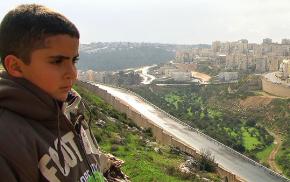Cinematic Intifada
reviews the Academy Award-nominated Palestinian film Five Broken Cameras.
GREAT POLITICAL films imagine new ways of both seeing and making the world.
Sergei Eisenstein created his montage editing technique to represent the revolutionary clash of opposing political classes in 1905 Russia in Battleship Potemkin. Gillo Pontecorvo developed a style that could be called guerilla documentary to represent FLN resistance to French colonial occupation in the 1967 film Battle of Algiers.
In their Oscar-nominated film Five Broken Cameras, Palestinian farmer Emad Burnat and Israeli filmmaker Guy Davidi have invented the cinematic Intifada.
Five Broken Cameras uses hand-held video cameras to record five years of attempted Israeli encroachment onto Palestinian land in the West Bank village of Bil'in. In 2005, Israeli settlers built a barrier near Bil'in that separated villagers from valuable farmland. In the film, every time settlers show up to try to claim the land, Burnat shows up with his camera to record the event.
The camera itself becomes a metaphor for the reality that to be a witness for Palestinian resistance, to resist itself, is deadly. Five times in the movie Israeli violence destroys Burnat's camera. Once, the camera saves his life when it takes a bullet.

The film's time-lapse structure allows us to experience organically the development of Palestinian resistance to occupation. Early on we meet Bassem Abu Rahme, nicknamed Pheel (Arabic for elephant). He is Burnat's friend and neighbor. At the start of the film, he leads small-scale protests and stands undaunted in the face of Israeli weapons routinely fired at demonstrators.
The character of village resistance is altered when Israelis kill a young Palestinian boy. We see more people showing up at the barrier. Asymmetrical struggle between the most militarized society on earth and a peasant resistance movement is conveyed in encounters between bullets, trucks and tear gas on one side, and Palestinian flags, stones and video cameras on the other.
Near the end of the film, Rahme is killed by an Israeli tear-gas canister fired directly at him. His death ignites largest protests. As Burnat says in voiceover, sometimes the loss of one individual life makes others more willing to risk their own.
We see large crowds pushing back violently at helmeted Israeli soldiers at barricade. A small victory is earned when, after years of court deliberation, the barrier near Bil'in land is ordered moved back.
FIVE BROKEN Cameras also allows viewers to feel kinship with the Palestinian struggle. For example, Burnat begins his filming of the occupation of his village with the same video camera he acquires to film the birth of his son Gibreel.
Gibreel's young eyes "open" to the occupation as ours do. We also see Burnat's brother arrested and his father throw himself in desperation on the hood of an Israeli police car in protest.
Five Broken Cameras becomes a "home movie" about everything an indigenous people may lose in the act of being colonized.
Outside of the frame, this documentary tells us how Israel is losing the public relations war to legitimate apartheid. Its Oscar nomination brought the Palestinian struggle unprecedented media attention.
When U.S. officials detained Burnat and his wife and son as they were trying to enter the country for the Oscars ceremony, Michael Moore tweeted his outrage and mainstream media outlets splashed their detention across the web.
Footage used in making the film was lent to other filmmakers for documentaries against the occupation, and has appeared stand alone on YouTube. In part and as a whole, Five Broken Cameras has allowed the Palestinian resistance to go viral.
Israeli government and media attempts to claim Five Broken Cameras as an "Israeli" film have also imploded. Both Burnat and Davidi have argued vociferously that the film's perspective is Palestinian, while Davidi has reaffirmed his support for the boycott, divestment and sanctions campaign against Israel.
Meanwhile in Bil'in, weekly demonstrations against the occupation at the Apartheid Wall continue to this day. Life imitating art imitating life.
For all of these achievements, Five Broken Cameras is a landmark of the Palestinian resistance, and a slingshot strike against the Israeli occupation. Now more than ever, the film tells us, the whole world is watching.


